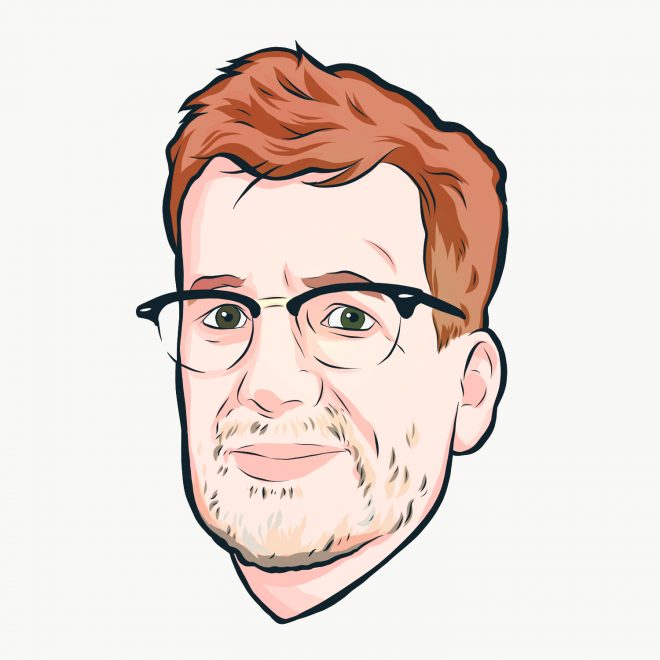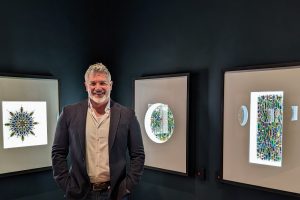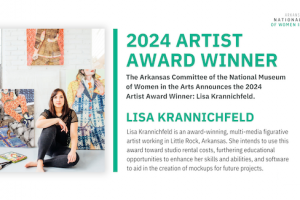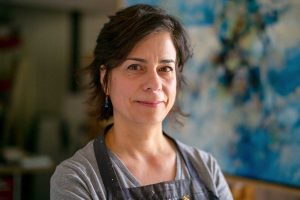THE LEGACY ISSUE: The Voice of the Ozarks

You might not know what Kyle Kellams looks like, but if your radio dial has found its way to KUAF 91.3 FM at any point in the last three decades, you know his voice. It has a gravitas that is more inquisitive than authoritative. He’s always searching, probing his guests for answers so he can bring those answers to the people.
Kyle began his career in radio at KTLO in Mountain Home while in high school in 1980. He worked at the 10-watt wonder version of KUAF in college, returned to KTLO after college and briefly served as news director at KIX-104. In 1989, Kyle came back to KUAF and started producing Ozarks at Large in March the next year. The program became a daily show in August 2010. For several years he was the play-by-play radio voice for the University of Arkansas Razorback women’s basketball team. He’s married to Laura King Kellams and has read almost every Icelandic murder mystery written.
How did Ozarks at Large come about?
The program actually began in the 1980s as a 30-minute, weekly interview program hosted by Dave Edmark and James Russell. Shortly after I started at KUAF in August 1989, both of the hosts had reasons to leave the show and I took over. Over time it expanded from once a week to the six-days-a-week, 60-minute show it is now.
How has Ozarks at Large changed over the years?
We evolved from just one interview to all kinds of stories. The staff grew, the frequency of shows grew. The show continues to evolve, too. The shows since the pandemic have stressed, even more, the importance of daily updates to major stories like the virus, the election and more.
How important is community radio, in your opinion?
As more broadcast outlets become owned and programmed by entities owned outside of the cities where the broadcast originates, public and community radio can offer local stories, voice and music.
Do you have any outstanding interviews or stories that you are proud of in your career?
Plenty. My conversation with Bruce Dern (connected with the Bentonville Film Festival) was a highlight. I became quite adept at editing bleeps into the interview. There was an early conversation with Jackie Torrence remains a favorite because of her attitude toward grace and life. The singer Rumer in the Firmin-Garner Performance Studio. There are so many over the past 31 years that left made an impact.
Do you have any embarrassing moments you’d like to share?
Since the show is almost always produced before airtime, embarrassing moments are edited out and often erased from my memory. Not associated with the show, but in front of a few hundred people, was the time a few years ago I fell off the stage hosting a fundraiser for the Fayetteville Public Education Foundation.
How do you view objectivity in the context of modern journalism and media consumption?
There’s a great question. The effort to report the truth behind a story hasn’t altered in a changing media landscape. I think almost all reporters/interviewers desire to be as objective as possible. Part of that effort includes trying to be aware of all of the biases that could exist.
How have you seen the nature of radio news or news consumption in general change over the years?
An incredible change. We can all be content producers with social media and can all determine just who or what we want to read, see and hear. An advantage is that more diverse voices can be part of the landscape. A disadvantage is that far more information can be shared than can be vetted.
Your position with the station has turned you into a public figure in the community. What sort of balance must you strike to maintain your integrity as a journalist?
That’s a great question. I absolutely love my chances to work with other organizations in the region. If there is any chance a story about one of those organizations needs to be handled by somebody else on the Ozarks at Large staff, there are wildly talented people like Antoinette Grajeda, Jacqueline Froelich, Daniel Caruth, Timothy Dennis and Zuzanna Sitek to work on those stories.
What is something you wished the public understood about journalism that they may not realize?
Real reporters are most interested in getting to the truth of a story and struggle (before and after the story is produced) with making sure as many angles are covered as possible.
What are your predictions for the future of community radio, whether it be your program or the medium in general?
I’d say it’s a robust future…as long as finances are good. The desire for stories based in the places where people live will only increase.
Let’s get philosophical for a second, does truth really exist?
It does. But it is rarely, if ever, a single-layered phenomenon. Rarely a single truth, but many angles that add up to a truth.





Comments